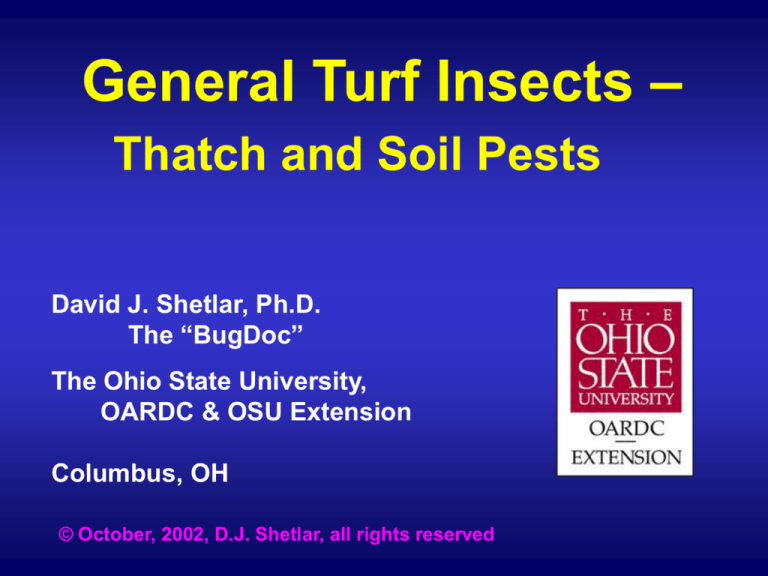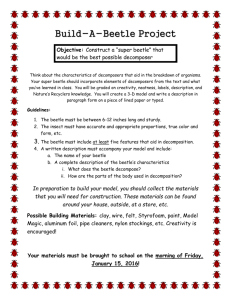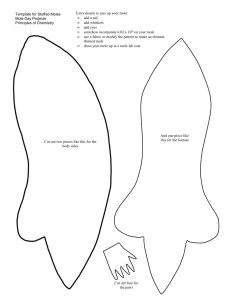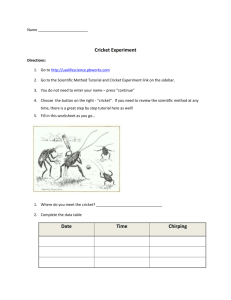
General Turf Insects –
Thatch and Soil Pests
David J. Shetlar, Ph.D.
The “BugDoc”
The Ohio State University,
OARDC & OSU Extension
Columbus, OH
© October, 2002, D.J. Shetlar, all rights reserved
Thatch & Soil Pests
Chewing Pests
White Grubs
Mole Crickets
Sucking Pests
Ground Pearls
Root Aphids
White Grub
Damage
Annual White Grub Species
• Masked Chafers (North America - N, S, SW, W, SE)
• Japanese Beetle (eastern NA)
• Oriental Beetle (northeastern NA)
• European Chafer (northeastern NA)
• Asiatic Garden Beetle (northeastern NA)
• Green June Beetle (south-transition NA)
• May/June Beetles (southern only)
White Grub Adults
Annual Grubs
GJB, EC, SMC, NMC, JB, OB, AGB
Multi-year Grubs, M/JB
Multi-gen/yr Grub, BTA
White Grub Third Instars
Annual Grubs
GJB,
EC,
Multi-year Grubs, M/JB
MC,
JB,
OB, AGB
Multi-gen/yr Grub, BTA
Identifying Grub Species
• Identify grubs by raster pattern
Japanese beetle has V-shaped pattern.
• Adults are easy to ID
but they don’t predict grub populations!
Japanese Beetle –
Japanese beetle adult skeletonizing leaf
Mating cluster of beetles in turf
Japanese beetle distribution (2000)
Japanese Beetle Life Stages
egg
1st
2nd
instar larva
3rd
pupa
adult
Japanese Beetle Annual Cycle
JAN FEB MAR APR MAY JUN JUL AUG SEP OCT NOV DEC
Masked Chafers –
Pair of masked chafers at night on turf
Masked chafer eggs
newly laid (below)
48 hours in moist soil (above)
Identifying Grub Species
Masked chafers have no pattern!
Masked Chafer Distribution Maps
Northern Masked Chafer
Southwestern Masked Chafer
Southern Masked Chafer
Western Masked Chafer
Northern Masked Chafer Life Stages
egg
1st
2nd
instar larva
3rd
pupa
adult
Masked Chafer Annual Cycle
Mature grub “crawling” on soil
Green June Beetle –
Adult
Overwintering Japanese beetles
Grub in overwintering burrow
Identifying Grub Species
GJB grubs crawl on their backs!
Green June Beetle Distribution
Green June Beetle Life Cycle
Soil mounds
around burrows in
fall. Note thinning
of turf where
grubs have come
to the surface to
feed.
Spring “clean-out” mounds
from green June beetles on a
golf course fairway.
European Chafer –
Adult
© H. Niemczyk
European chafer adults swarming to tree at dusk for mating
Identifying Grub Species
European chafers have Y-shaped anus
& two rows of bristles that diverge at anus.
Y-shaped anus with two rows of bristles.
European Chafer Distribution (2000)
European Chafer Life Cycle
Oriental Beetle &
Asiatic Garden Beetle –
Three common color forms of Oriental beetle
Asiatic garden beetles feeding & mating
Identifying Grub Species
Oriental beetle has two
rows of small spines, 12-15
in number.
Asiatic garden beetle has
vertical anus & broad U-shaped
spine pattern.
Oriental Beetle & Asiatic Garden Beetle
Distribution Maps
Oriental Beetle (2000)
Asiatic Garden Beetle (2000)
Black Turfgrass Ataenius (& Aphodius)
BTA adults have a smooth hind tibia while Aphodius has three spurs.
Identifying Grub Species
Ataenius raster is random pattern of
bristles and anal pads separate.
Aphodius raster has small V pattern
and anal pad is only cleft, not
divided.
Black Turfgrass Ataenius Distribution
Aphodius granarius is mainly northern in distribution.
Black Turfgrass Ataenius Life Cycle in Ohio
BTA damage first appears as turf that wilts in the afternoon
heat, but recovers when irrigated. A few days later, the turf
will not recover for more than a day or several hours. At this
point it is near death!
Turf killed by BTA larvae in late June and early July. These patches
can continue to expand, so rapid action is essential for saving the turf!
May/June Beetles, Phyllophaga –
Most Phyllophaga are listed as being multipleyear life cycle species, but many of the
southern species are annual grubs.
Adult Phyllophaga
commonly feed on the
leaves of local trees.
Identifying Grub Species
Phyllophaga grubs generally have two
parallel rows of bristles DO NOT diverge at
the anus (like European chafers).
Diagram of a Phyllophaga
species with a three-year
life cycle. Note that the
adults are formed in
September and overwinter
in their last year of
development.
Life Cycles of Common White Grubs Found in Ohio
© HDN
Target
Principle
© HDN
Where do
grubs feed?
Ans:
Soil-Thatch
Interface
© HDN
What do
grubs eat?
Ans:
THATCH, soil
(oh, and roots)
Northern Masked Chafer Life Stages
Egg
Larva
1st
2nd
Instar
Pupa
Adult
3rd
NOTE: if the first instar grub is “one unit”
of weight, the second instar is about 15 to
20 units and the third instar is 35 to 50
units.
A study in California to determine the relative
susceptibility of masked chafer first, second and
third instar grubs to an insecticide, diazinon in this
case. They found the following relative
susceptibility of these instars:
• First Instar – 1 unit
• Second Instar – 26 units
• Third Instar – 120 units!
Therefore, grub susceptibility to insecticides does not appear to be a
“straight line” effect of body weight!
Japanese Beetle Annual Cycle
JAN FEB MAR APR MAY JUN JUL AUG SEP OCT NOV DEC
Preventive-Early Curative Timing
Traditional Control Timing
Ranked Efficacy of White Grub Insecticides
1976 – 2001a
Insecticide
rate
ave
range
lb.ai./a. % control # tests % control
Thiamethoxam
(=Meridian)
Halofenozide
(=MACH2)
Imidacloprid
(=Merit)
Trichlorfon
(=Dylox, Proxol)
Carbaryl
(=Sevin)
Diazinon
Chlorpyrifos
(=Dursban)
a
% of tests
below 70%
0.2
96.1
38
0-100
3
1.5
92.8
57
10-100
10
0.3
93.7
58
58-100
7
8.0
77.6
90
0-98
19
8.0
74.3
40
13-100
37
4.0
5.5
4.0
69.0
74.8
54.6
20
41
32
47-99
25-100
0-96
42
29
59
Data from ESA publications (1977-2001) using masked chafer and Japanese beetle data where label timing
recommendations were used and at least 4.0 grubs per sq.ft. were found in checks.
Comparison of Grub Insecticide Efficacy
by
Time of Application
Insecticide
rate
lb.ai./a.
May
ave % control (#tests)
June
July
to Aug 16
to Sept 10
Halofenozide
(=MACH2)
1.5
92.8 (6)
96.8 (18)
92.2 (15) 92.0 (13)
80.3 (22)
Imidachloprid
(=Merit)
0.3
90.2 (8)
91.8 (16)
94.9 (16) 95.6 (17)
96.5 (29)
Thiamethoxam 0.2
(=Meridian) 0.26
80.0 (5)
91.5 (4)
98.8 (11)
99.3 (3)
98.6 (9) 98.3 (11)
99.3 (2) 98.0 (6)
93.7 (8)
100.0 (4)
Trichlorfon
---
---
---
8.0
91.0 (2)
83.3 (12)
Mole Crickets
Tawny Mole Cricket
Scapteriscus vicinus Scudder
Southern Mole Cricket
S. borellii Giglio-Tos
(=S. acletus Rehn & Hebard)
Short-winged Mole Cricket
S. abbreviatus Scudder
Native Mole Cricket
Gryllotalpa hexadactyla Perty
Mole cricket damage to bermudagrass.
Native (northern) mole cricket
Tawny mole cricket
Southern mole cricket
Shortwinged mole cricket
Native Mole Cricket
Southern Mole Cricket
Tawny Mole Cricket
Shortwinged Mole Cricket
Mole Cricket Management Schedule
March - April
Map Course for Adult Activity
(where adults tunnel and break surface is where eggs will be laid
or PREVIOUS RECENT HISTORY OF DAMAGE MAY BE USED)
Visual rating
(based on experience)
Grid rating
(numbers must be "calibrated")
Mole Cricket Management Schedule
May - June
Nymph Target Applications
(young nymphs most likely where spring adult activity was located)
Monitor - Soap Flush
Treatments
Sprays
Subsurface
Mole Cricket Management Schedule
July - September
Large Nymph Scouting
(may occur in places not treated earlier or where poor control)
Monitor - Soap Flush
Treatments
Sprays
Baits
Mole Cricket Management Schedule
October - December
Map Lawns for Activity
(large nymphs and adults tunnel and break surface)
Visual rating
Grid rating
Treatments
Sprays
Baits
Nematodes ??
Mole Cricket Pesticides (curative)
• acephate (Orthene)
• carbaryl (Sevin)
• trichlorfon (Dylox, Proxol)
• fipronil (Chipco Choice)
slit-placement only
(by contract applicator, not lawns)
Mole Cricket Pesticides (curative)
• bifenthrin (Talstar)
• cyfluthrin (Tempo)
• lambda-cyhalothrin (Scimitar)
• permethrin (Astro)
Mole Cricket Pesticides (preventive)
• imidacloprid (Merit)
• fipronil (Chipco Choice)
slit-placement only
(by contract applicator, golf only)
Merit is most effective
when applied between
start of egg laying and
egg hatch. Adult
female mole cricket
eggs are yellow when
ready to be laid.
Sample adults in April
and May to look for
egg development.
Immature eggs on left,
mature eggs on left.
Occurrence of Target Lawn Insect Pests
April
May
CG
CG
C G-prv
C G-prv
C BB/a
C BB/a
C BB/l-prv
C BB/l-prv
C CB/a
June
July
August
Sept
CG
CG
C G-prv
C G-prv
C G-prv
C BB/l
C BB/l
C BB/a
C BB/a
C CB/a
C CB/n
C CB/n
C CB/n&a
C CB/a
C CB/n-sup
C CB/n-sup
C CB/n-sup
C CB/n-sup
C CB/n-sup
C SWW
C SWW
C SWW
C SWW
C SWW
C SWW
C Aph-prv
C Aph-prv
C Aph-prv
C Aph-prv
C Aph-prv
C Aph-prv
CG
Occurrence of Target Lawn Insect Pests
April
May
CG
CG
C G-prv
C G-prv
C BB/a
C BB/a
C BB/l-prv
C BB/l-prv
C CB/a
June
July
August
Sept
CG
CG
C G-prv
C G-prv
C G-prv
C BB/l
C BB/l
C BB/a
C BB/a
C CB/a
C CB/n
C CB/n
C CB/n&a
C CB/a
C CB/n-sup
C CB/n-sup
C CB/n-sup
C CB/n-sup
C CB/n-sup
C SWW
C SWW
C SWW
C SWW
C SWW
C SWW
C Aph-prv
C Aph-prv
C Aph-prv
C Aph-prv
C Aph-prv
C Aph-prv
controlled with CONSERVE
®
CG
Occurrence of Target Lawn Insect Pests
April
May
CG
CG
C G-prv
C G-prv
C BB/a
C BB/a
C BB/l-prv
C BB/l-prv
C CB/a
June
July
August
Sept
CG
CG
C G-prv
C G-prv
C G-prv
C BB/l
C BB/l
C BB/a
C BB/a
C CB/a
C CB/n
C CB/n
C CB/n&a
C CB/a
C CB/n-sup
C CB/n-sup
C CB/n-sup
C CB/n-sup
C CB/n-sup
C SWW
C SWW
C SWW
C SWW
C SWW
C SWW
C Aph-prv
C Aph-prv
C Aph-prv
C Aph-prv
C Aph-prv
C Aph-prv
®
controlled with MACH2
CG
Occurrence of Target Lawn Insect Pests
April
May
CG
CG
C G-prv
C G-prv
C BB/a
C BB/a
C BB/l-prv
C BB/l-prv
C CB/a
June
July
August
Sept
CG
CG
C G-prv
C G-prv
C G-prv
C BB/l
C BB/l
C BB/a
C BB/a
C CB/a
C CB/n
C CB/n
C CB/n&a
C CB/a
C CB/n-sup
C CB/n-sup
C CB/n-sup
C CB/n-sup
C CB/n-sup
C SWW
C SWW
C SWW
C SWW
C SWW
C SWW
C Aph-prv
C Aph-prv
C Aph-prv
C Aph-prv
C Aph-prv
C Aph-prv
controlled with MERIT
®
CG





